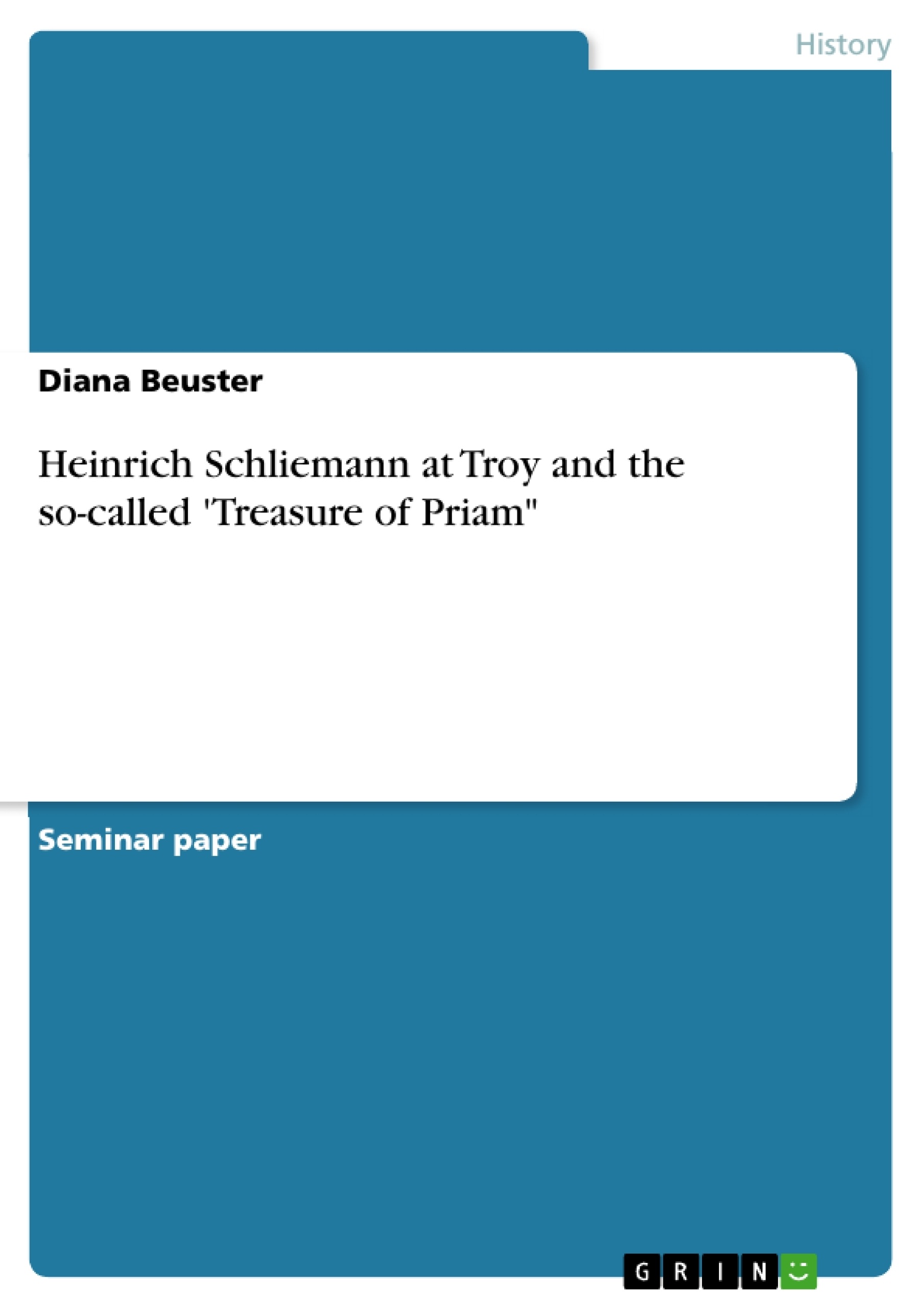The discovery of Hisarlik as Troy by Heinrich Schliemann was certainly one of the most sensational news stories of the nineteenth century. Hisarlik is now commonly assumed to be the site of Troy, the city in and around which Homers Iliad took place. With his extraordinary find, Schliemann radically started to redirect scholarly thinking about the ancient past and, no less he started a controversy about himself, his life and his methods. That controversy, starting back in his own days and still continuing more than 100 years after his death, was in the beginning mainly fought by Schliemann’s own fellow countryman, but it’s nowadays a fully international debate.
The paper not only covers bibliographical facts of Schliemann’s life and work, but also the period of his excavation of Troy and the question whether the ‘Treasure of Priam’ was forged by him or not.
Table of Contents
- Some short notes on Schliemann's life
- Troy and the Troad before Schliemann's first excavation cycle
Objectives and Key Themes
This text aims to provide a concise overview of Heinrich Schliemann's life and his first excavation cycle at Troy, focusing on his methods, controversies, and the significance of his discoveries. It explores the context of his work, both personal and academic, leading up to the discovery of the "Treasure of Priam."
- Heinrich Schliemann's life and career trajectory.
- The archaeological context of Troy before Schliemann's excavations.
- Schliemann's excavation methods and their controversies.
- The discovery and significance of the "Treasure of Priam."
- The impact of Schliemann's work on the field of archaeology.
Chapter Summaries
Some short notes on Schliemann's life: This section details Heinrich Schliemann's life, from his humble beginnings and self-education to his entrepreneurial success that funded his archaeological pursuits. It highlights his linguistic abilities, global travels, and early interest in archaeology, emphasizing the complex interplay between his personal ambitions and his scholarly endeavors. The narrative underscores the evolution of his approach to archaeology and his evolving relationship with the academic community, particularly the initial controversies surrounding his methods and interpretations. The section also covers his marriages and the significant role of his wife Sophia in supporting his work.
Troy and the Troad before Schliemann's first excavation cycle: This chapter explores the historical and geographical context surrounding the location of Troy before Schliemann's excavations. It discusses the various sites considered potential candidates for Homer's legendary city and examines the scholarly debates and uncertainties that prevailed prior to Schliemann's intervention. This section sets the stage for understanding the significance of Schliemann’s discoveries and the lasting impact of his work on the understanding of ancient Troy.
Keywords
Heinrich Schliemann, Troy, Hisarlik, Treasure of Priam, archaeology, Homer, Iliad, excavation methods, Mycenaean civilization, ancient history, controversies, 19th-century archaeology.
Heinrich Schliemann's First Excavation Cycle at Troy: Frequently Asked Questions
What is the purpose of this text?
This text offers a concise overview of Heinrich Schliemann's life and his initial excavation efforts at Troy. It emphasizes his methodologies, the controversies surrounding his work, and the importance of his discoveries, particularly the "Treasure of Priam." The text also examines the personal and academic contexts that shaped his work.
What topics are covered in the text?
The text covers several key areas: Schliemann's life and career; the archaeological understanding of Troy before Schliemann; his excavation techniques and the debates they sparked; the discovery and significance of the "Treasure of Priam"; and the lasting impact of Schliemann's work on the field of archaeology.
What are the main chapters or sections of the text?
The text is divided into sections covering: "Some short notes on Schliemann's life," detailing his background and career trajectory; and "Troy and the Troad before Schliemann's first excavation cycle," which provides the historical and geographical context of the Troy excavations.
What is discussed in the chapter "Some short notes on Schliemann's life"?
This section explores Schliemann's life from his humble beginnings to his entrepreneurial success which financed his archaeological endeavors. It highlights his linguistic skills, his extensive travels, his early interest in archaeology, and the complex relationship between his personal aspirations and his scholarly work. It also addresses the controversies surrounding his methods and interpretations, and the role of his wife Sophia in supporting his work.
What is covered in the chapter "Troy and the Troad before Schliemann's first excavation cycle"?
This chapter examines the historical and geographical context of Troy before Schliemann began excavating. It discusses various sites proposed as the location of Homer's legendary city and the scholarly uncertainties that existed prior to Schliemann's work. It helps to establish the significance of Schliemann's discoveries and their impact on our understanding of ancient Troy.
What are the key themes explored in the text?
The key themes include Schliemann's personal drive and ambition; the archaeological methodologies of the 19th century and their limitations; the controversies surrounding Schliemann's interpretations and excavations; the impact of his discoveries on the understanding of ancient Troy and Mycenaean civilization; and the relationship between personal ambition and scholarly pursuit.
What are the keywords associated with this text?
Key words include: Heinrich Schliemann, Troy, Hisarlik, Treasure of Priam, archaeology, Homer, Iliad, excavation methods, Mycenaean civilization, ancient history, controversies, and 19th-century archaeology.
What is the overall significance of Schliemann's work, as discussed in the text?
The text emphasizes the lasting impact of Schliemann's work, despite the controversies surrounding his methods. His discoveries significantly advanced our understanding of ancient Troy and the Mycenaean civilization, even though modern archaeology critiques some of his methods and interpretations.
- Quote paper
- M.A. Diana Beuster (Author), 2008, Heinrich Schliemann at Troy and the so-called 'Treasure of Priam", Munich, GRIN Verlag, https://www.grin.com/document/128662




